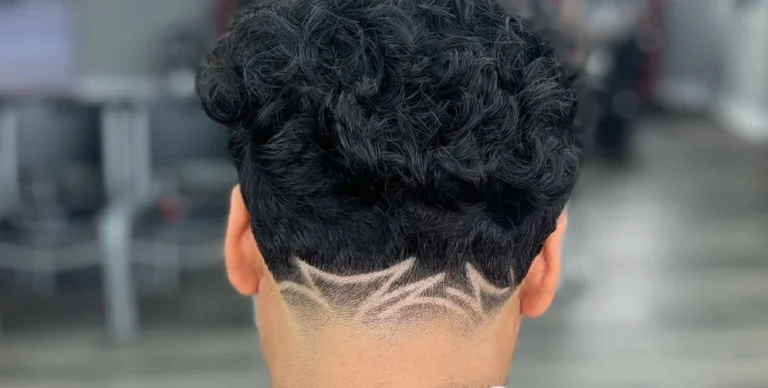Caesar Haircut: The Timeless Men’s Hairstyle Reinvented for 2025
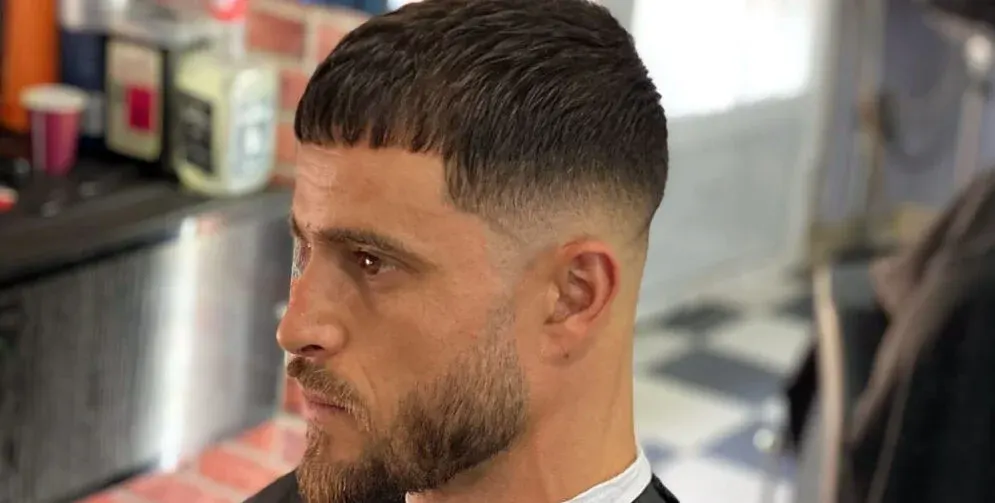
Once a Roman classic, the Caesar haircut returns in 2025 with a modern, versatile edge. It blends clean lines, a short horizontal fringe, and practical ease for daily life. Barbers favor it because it frames faces and hides early hairline changes. Celebrities and street style reshaped the cut into smart modern variations.
As someone who’s tested dozens of styles across real barbershops, I’ve seen why this one never fades. The Caesar cut works because it’s bold, balanced, and easy to maintain — perfect for men who value style without stress.
In this guide, you’ll discover its history, who it suits, and how to ask for it confidently at the barber. I’ll show step-by-step cutting tips, styling routines, and real-world before and after cases. In 2025, textured finishes and softer fringes are redefining this timeless look — and I’ll reveal the exact products and grooming routines barbers recommend.
Whether you’re managing a receding hairline or chasing a clean, low-effort style, this guide helps. Ready to rethink a classic? Let’s start with the basics.
What Is a Caesar Haircut?
The Caesar haircut is a short men’s hairstyle defined by a straight horizontal fringe across the forehead and evenly cut sides and back. Unlike trendy fades or disconnected cuts, it maintains balance and simplicity, making it one of the easiest low-maintenance hairstyles to manage daily. It’s recognized by barbers worldwide for its structured form and clean silhouette.
In 2025, the Caesar cut continues to trend for men who prefer a clean, structured look with minimal upkeep.
Key Features That Define It:
- Short length, usually 1–2 inches on top
- A blunt, straight fringe brushed forward
- Even layering throughout for a clean structure
- Minimal styling products required
The cut’s name comes from Julius Caesar, the Roman general and emperor. He wore a cropped style with hair pushed forward — both as a fashion statement and, according to historians, to mask early hair thinning. This association cemented the Caesar haircut as a symbol of strength, discipline, and timeless masculinity.
Visually, the Caesar cut looks sharp and structured, with a straight edge at the fringe that suits both professional and casual settings. While it shares similarities with the French crop, the difference is clear: the Caesar’s fringe is shorter, flatter, and more uniform, whereas the French crop is looser and textured, often paired with fades.
Barber Tip: Ask for a uniform cut with a #2 guard on top and sides to achieve the classic balanced Caesar look.
A Brief History of the Caesar Haircut
The Caesar haircut has carried influence for over two thousand years. Its story starts in Ancient Rome, where Julius Caesar himself popularized the short, forward-brushed style. Historians suggest he used it not only as a symbol of authority but also to mask early signs of baldness. The strong fringe became his trademark look — one that soldiers and citizens soon copied as a mark of discipline and order.
Fast forward to the 1990s, the Caesar cut resurfaced when George Clooney wore it during his ER television days. His version — short, cropped, and perfectly neat — inspired a generation of men who wanted a sharp yet approachable style. This era proved the haircut wasn’t just an ancient relic but a versatile choice for modern times.
In 2025, the Caesar has evolved again. Barbers now add texture, fades, and softer fringes, making it adaptable for different hair types and fashion-forward looks. From Hollywood to Tiktok, the Caesar is once again a trending cut, proving its resilience across centuries.
Barber Tip: For a modern update, ask your barber to add light texturing at the top while keeping the fringe structured — this keeps the look fresh without losing its roots.
Who Should Get a Caesar Haircut?
Best Face Shapes for Caesar Cut
The Caesar haircut suits men with oval, square, or longer face shapes. Its short fringe balances proportions and can soften strong jawlines or elongate round faces. This makes it a universally adaptable choice for many bone structures.
Barber Tip: If you have a longer face, keep the fringe slightly lower on the forehead to balance proportions. For round faces, add subtle texture on top to create height.
Ideal Hair Types (Straight, Wavy, Curly)
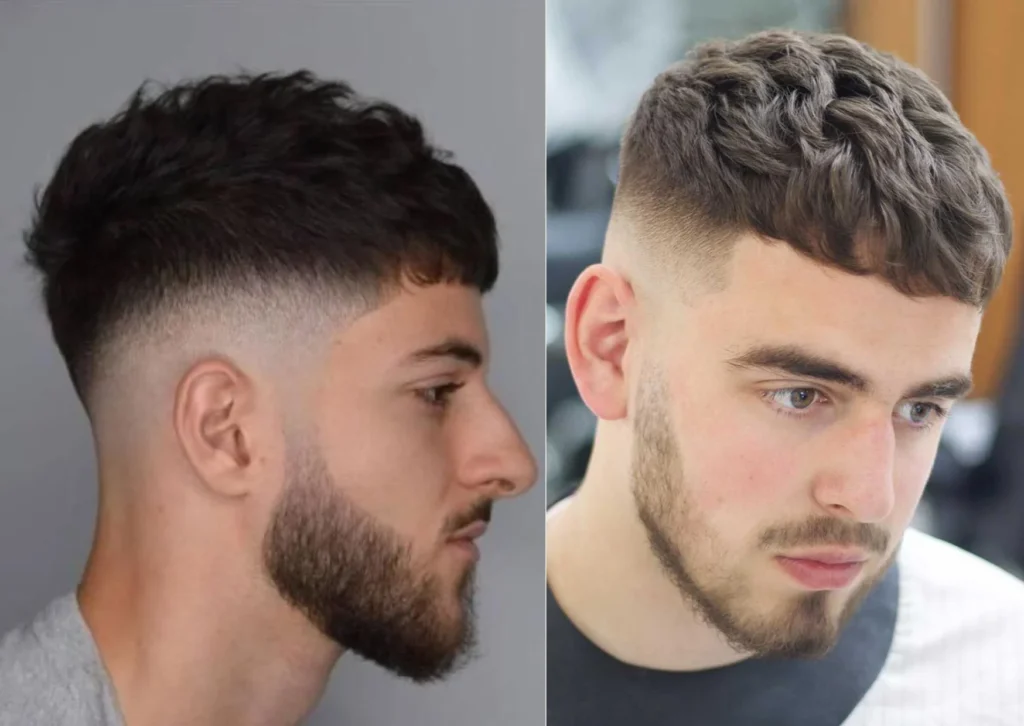
Whether hair is straight, wavy, or curly, the Caesar adapts well. Straight hair gives the cleanest look, wavy adds natural texture, and curly hair creates a bold, modern twist. Barbers recommend slight texturing for extra dimension in 2025 styles.
Caesar Haircut for Receding Hairline
One of the Caesar’s biggest advantages is its ability to mask a receding hairline. The forward fringe covers thinning spots, making it a go-to style for men in their 30s and 40s who want confidence without relying on heavy styling.
For men noticing early hair thinning, this cut brings back confidence — no heavy styling, no cover-ups, just clean structure.
Caesar Haircut for Black Men & Asian Men
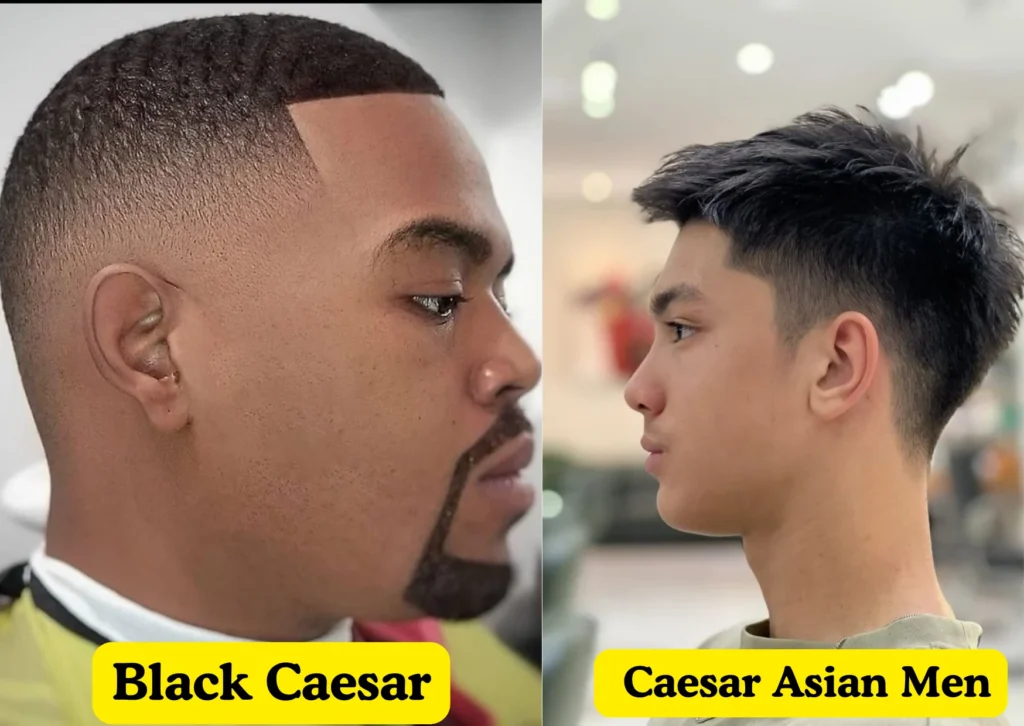
For Black men, the Caesar cut pairs perfectly with a short, even length — often called the Dark Caesar. For Asian men, it complements straight, thick hair by giving structure and clean edges. Both adaptations highlight cultural versatility.
Caesar Haircut for Women
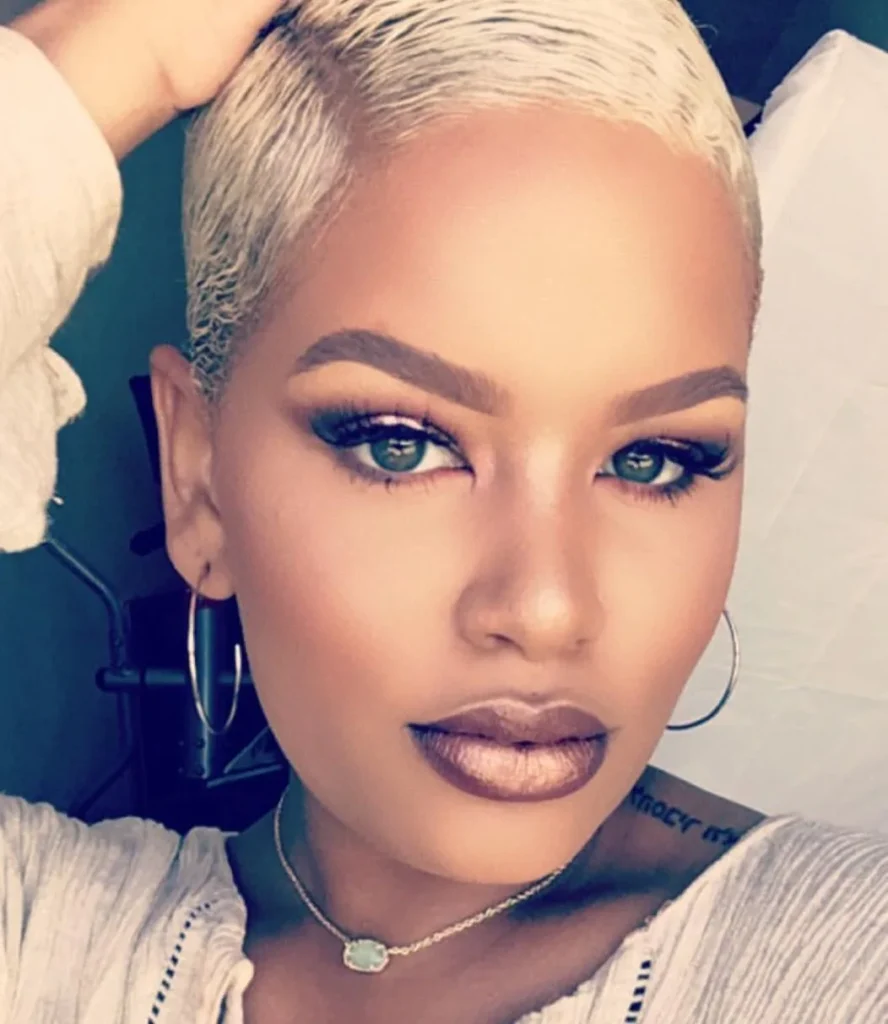
Women have also adopted the Caesar haircut in edgy, fashion-forward ways. Short fringes with textured sides create a bold, gender-neutral aesthetic that works well in high-fashion and street-style trends.
Caesar Haircut Variations (2025 Trend List)
Classic Caesar Haircut

The Classic Caesar is cut with short, even layers and a straight fringe across the forehead. It’s low-maintenance, frames the face cleanly, and remains one of the most practical styles for men in 2025. This version works best for professionals or students who want a neat, structured cut. Its timeless appeal keeps it relevant in both casual and formal settings.
Barber Tip: Ask for a uniform cut with a #2–#3 guard for balanced layering and even edges.
Best Face Shape: Oval or square — it sharpens features and hides minor hairline recession.
Modern Caesar Haircut
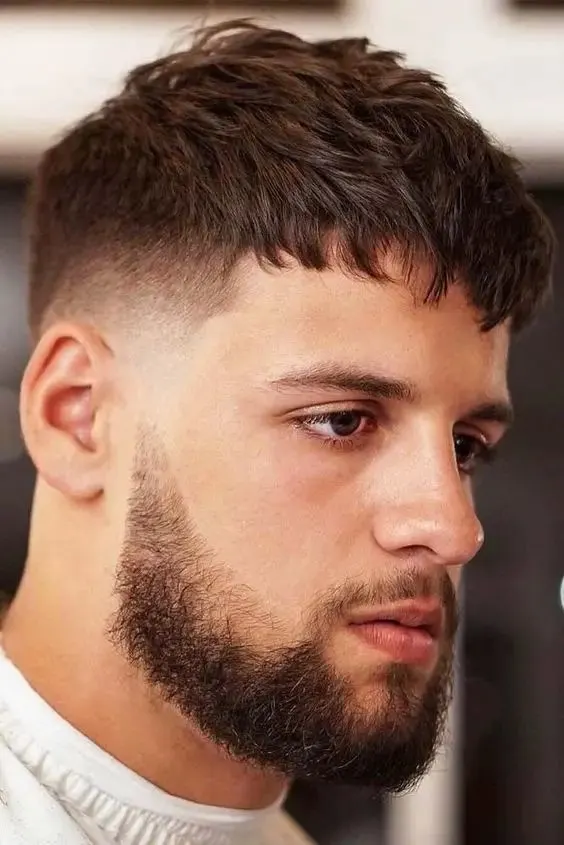
The Modern Caesar updates the classic with added texture on top and softer, layered fringes. It blends structure with a natural finish, making it versatile for both office wear and casual looks. In 2025, this style is especially popular because it adapts well to fashion trends without losing the Caesar identity. Men who want a sharper yet relaxed vibe often choose this cut.
Barber Tip: Use scissors for top texturing instead of clippers to give the hair movement.
Best Face Shape: Round or heart-shaped — the textured top adds height and balances proportions.
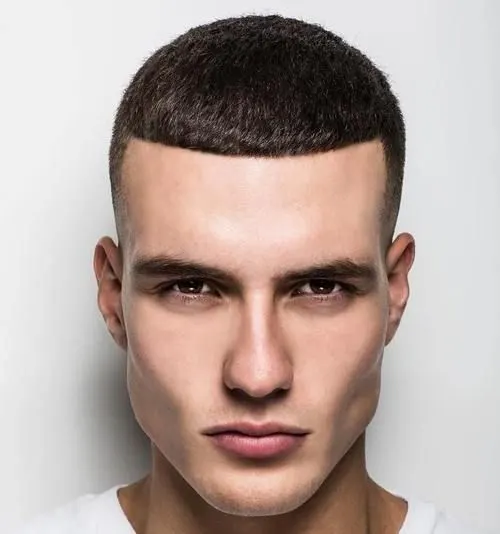
The Short Caesar keeps the hair extra tight on the sides and crown, with a short horizontal fringe. It’s one of the easiest versions to maintain, requiring minimal styling and looking sharp year-round. This cut is perfect for active men, athletes, or those who prefer a clean, military-inspired vibe. In 2025, it’s still trending because of its neatness and confidence-boosting appeal.
Barber Tip: Request a #1–#2 guard for the sides and a slightly longer #3 on top for balance.
Best Face Shape: Oval or diamond — it highlights structure while keeping proportions sharp.
Long Caesar Haircut
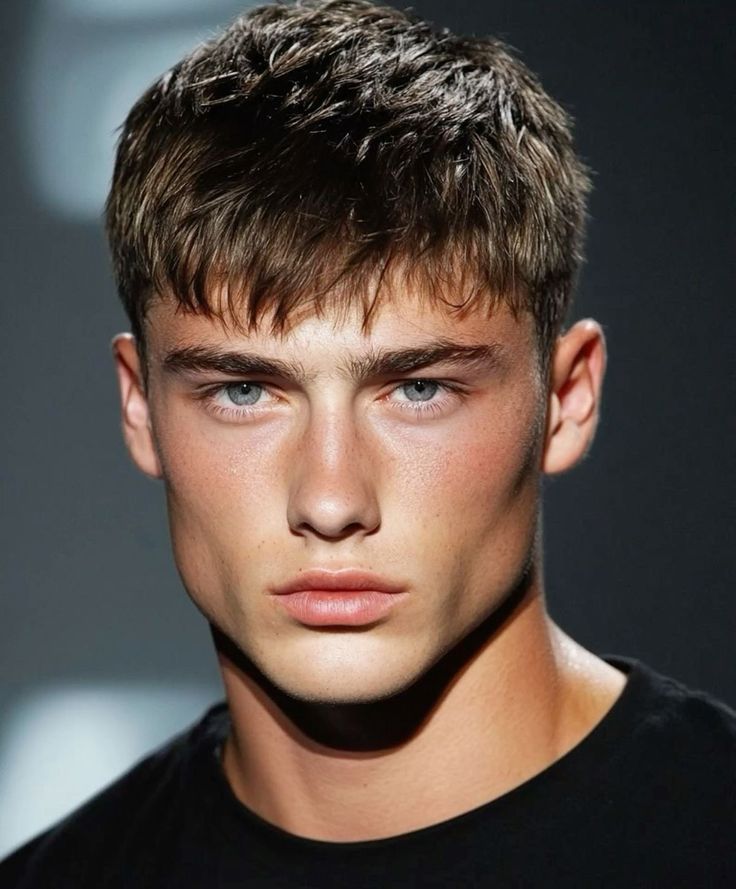
The Long Caesar extends the top layers slightly, giving the cut more flow and styling versatility. It works well for men who like a fuller look but still want the Caesar’s signature fringe. This version allows for light product use to create either a polished or tousled finish. In 2025, it’s favored by younger professionals and creatives who want structure with a modern edge.
Barber Tip: Keep the fringe trimmed with scissors instead of clippers to maintain softness.
Best Face Shape: Rectangle or oblong — the longer top balances out elongated features.
Textured Caesar Haircut
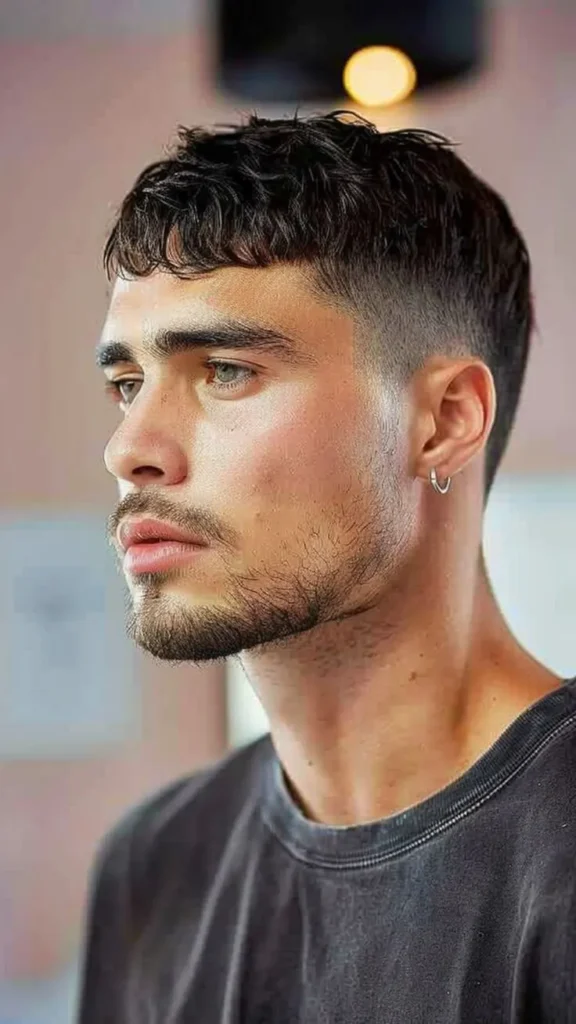
The Textured Caesar adds layers and choppy detail on top, giving movement and depth to the classic style. It’s a modern upgrade that suits men who want a less rigid, more fashionable version of the cut. This style works especially well with matte products like clay to highlight definition. In 2025, it’s one of the most requested Caesars because it balances sharpness with a casual vibe.
Barber Tip: Ask your barber for point-cutting on top to create texture and avoid flatness.
Best Face Shape: Round or oval — the extra height and movement add dimension to softer features.
Messy Caesar Cut
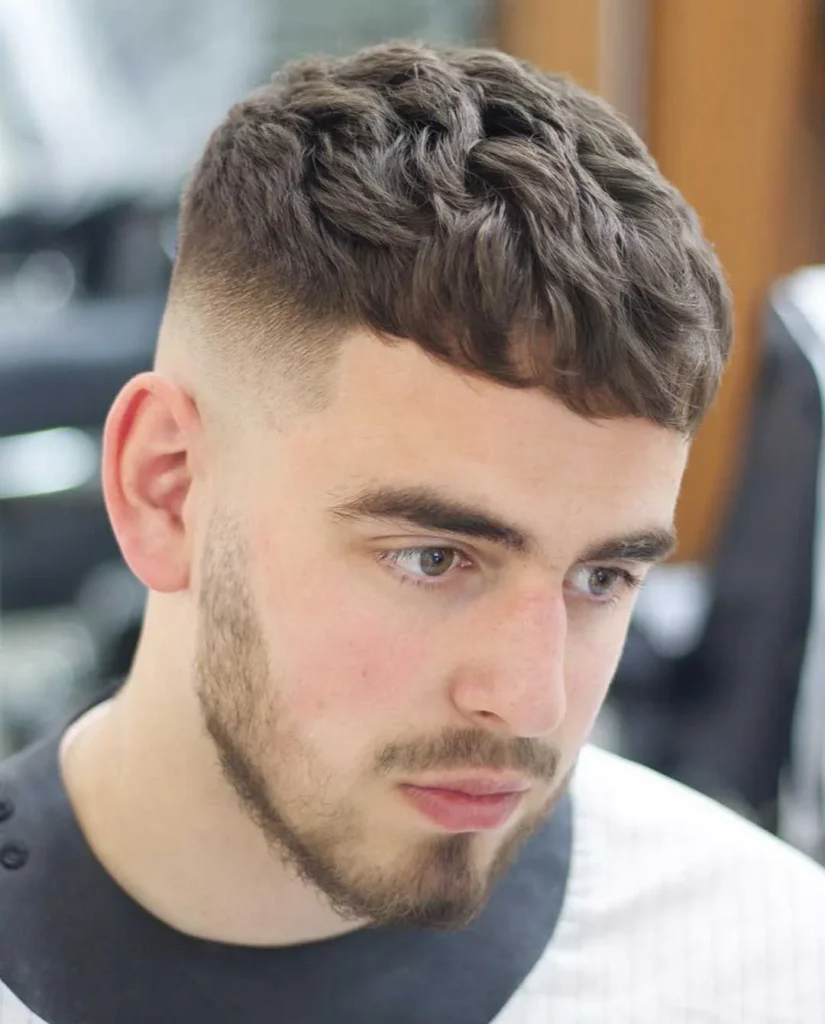
The messy Caesar is all about effortless style — short sides with a slightly undone, natural top. Instead of sharp lines, it leans casual, making it perfect for men who prefer a relaxed vibe. This cut shines when paired with light styling cream for a soft hold. In 2025, it’s trending among younger men who want a stylish yet low-maintenance look.
Barber Tip: Tell your barber to leave the fringe longer and use scissors instead of clippers for a natural, uneven finish.
Best Face Shape: Square or heart — the tousled top softens strong angles and adds balance.
Caesar Crop Haircut

The Caesar crop combines the classic straight fringe with a tighter, textured top. Unlike the messy version, it has a sharper, more polished vibe that barbers love for its clean silhouette. This style works well with fades on the sides, giving it a modern European edge. In 2025, the Caesar crop is especially popular in urban fashion scenes.
Barber Tip: Ask for a skin fade on the sides with scissor-textured layers on top for maximum definition.
Best Face Shape: Round or oval — the sharp fringe creates structure and contrast that balances softer features.
Curly Caesar Haircut
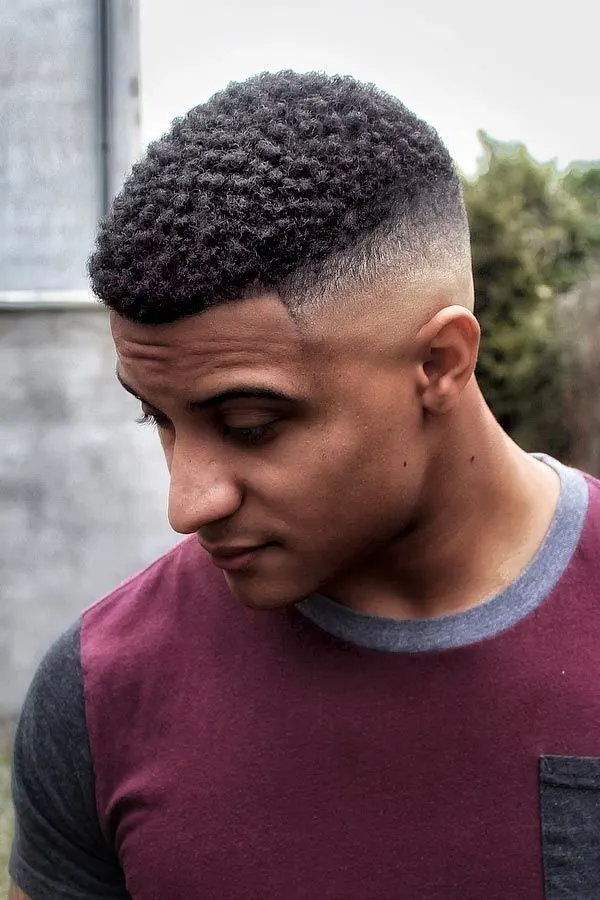
For men with natural curls or waves, the Caesar cut adds structure without fighting against texture. The short fringe keeps the look neat, while the curls on top bring a modern, stylish edge. This version is low-maintenance yet visually dynamic, making it a top pick in 2025 for men who want natural flow with clean sides.
Barber Tip: Keep the sides tapered short, but let the curls on top stay slightly longer for definition and bounce.
Best Face Shape: Square or oval — the waves soften strong angles while keeping balance with the jawline.
Low Caesar Haircut
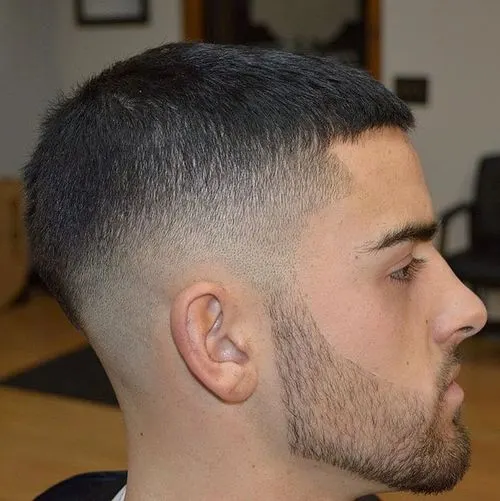
The low Caesar haircut sits shorter on the sides with minimal tapering, giving a subtle and clean profile. It’s ideal for men who want a sharp, understated style without dramatic contrasts. This cut keeps the focus on the fringe while maintaining a natural flow across the head. In 2025, it’s trending for professionals and students alike who prefer a neat, versatile look.
Barber Tip: Ask your barber to keep the fade very low, almost at ear level, for a polished yet natural transition.
Best Face Shape: Round — the low taper elongates the face, making it appear more balanced and structured.
Low Fade Caesar Haircut
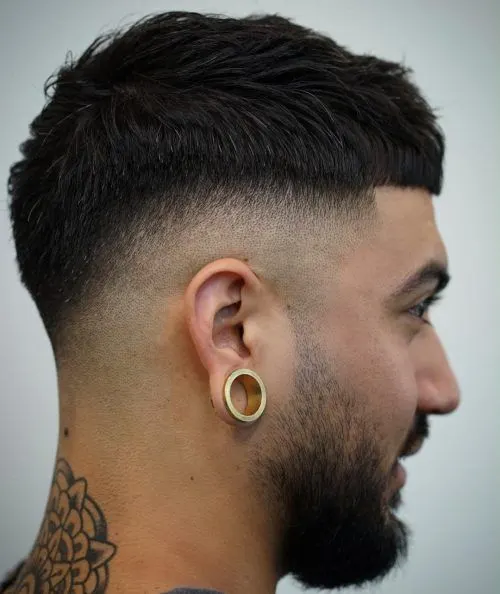
The low fade Caesar combines the timeless fringe with a modern fade starting just above the ears. This gives a clean, sharp finish while keeping the top length uniform. It’s especially popular in 2025 because it bridges the gap between casual and professional looks. The style works great for men who want a fresh update without going too bold.
Barber Tip: Tell your barber to blend the fade seamlessly into the fringe — this keeps the cut smooth and prevents harsh lines.
Best Face Shape: Square — the fade softens the jawline while the straight fringe enhances balance.
Caesar Taper Fade Haircut
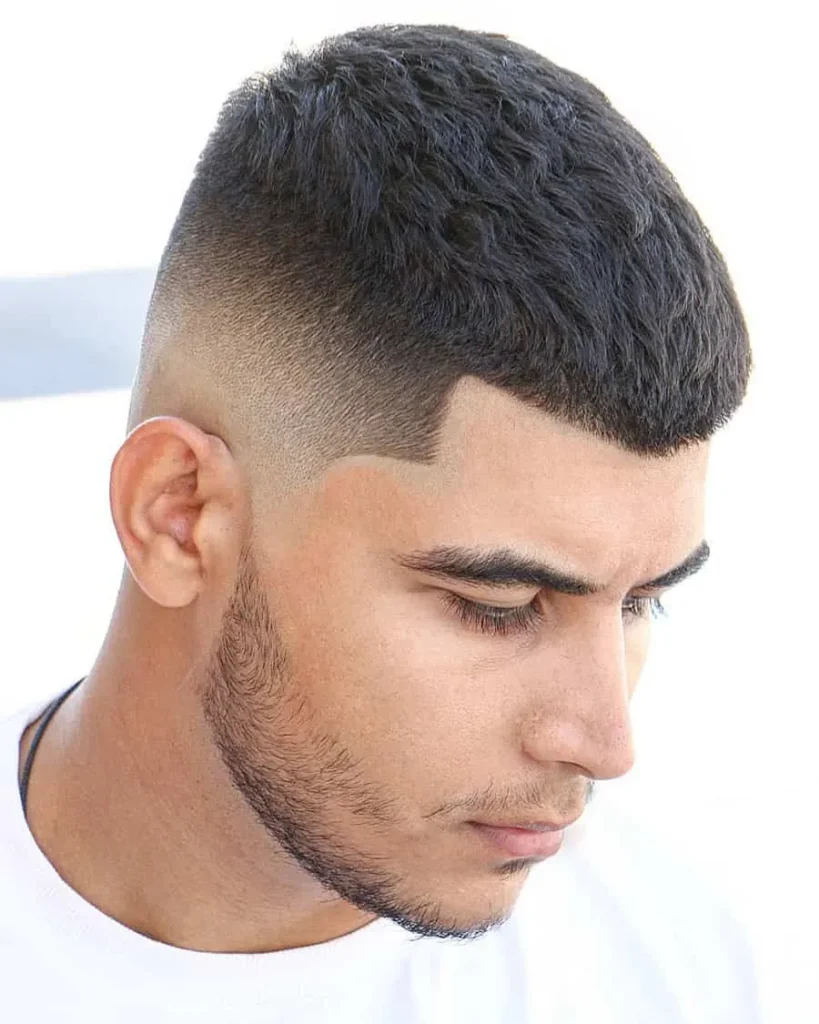
The Caesar taper fade is a refined version that gradually shortens the hair around the temples and neckline. Unlike the sharp low or high fades, the taper offers a more natural transition. It’s trending in 2025 for men who want a versatile, professional style that works in both office and casual settings. The taper adds structure without looking too extreme.
Barber Tip: Ask for a taper that follows your natural hairline closely — this keeps the haircut sharp for longer.
Best Face Shape: Round — the taper elongates the face slightly, giving it a leaner appearance.
Dark Caesar Haircut
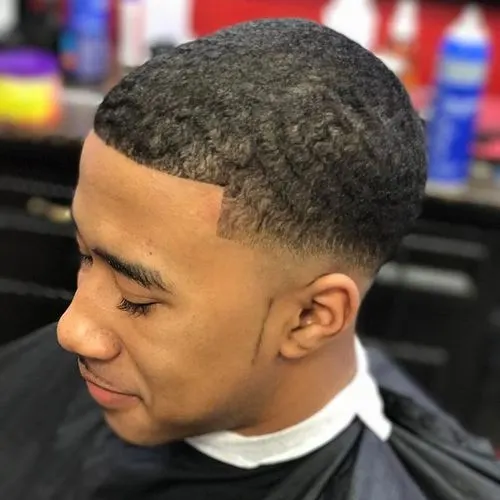
The dark Caesar is cut with a uniform low length (#1–#2 guard) across the head, keeping the look dense and neat. It’s especially popular among men with thick or coarse hair, as the darker finish emphasizes clean lines and strong structure. In 2025, it remains a go-to for minimalists who prefer sharp, disciplined grooming.
Barber Tip: Tell your barber you want a “uniform dark Caesar” with no taper for that solid, boxy finish.
Best Face Shape: Oval — the dark, uniform cut enhances balance and symmetry.
Light Caesar Haircut
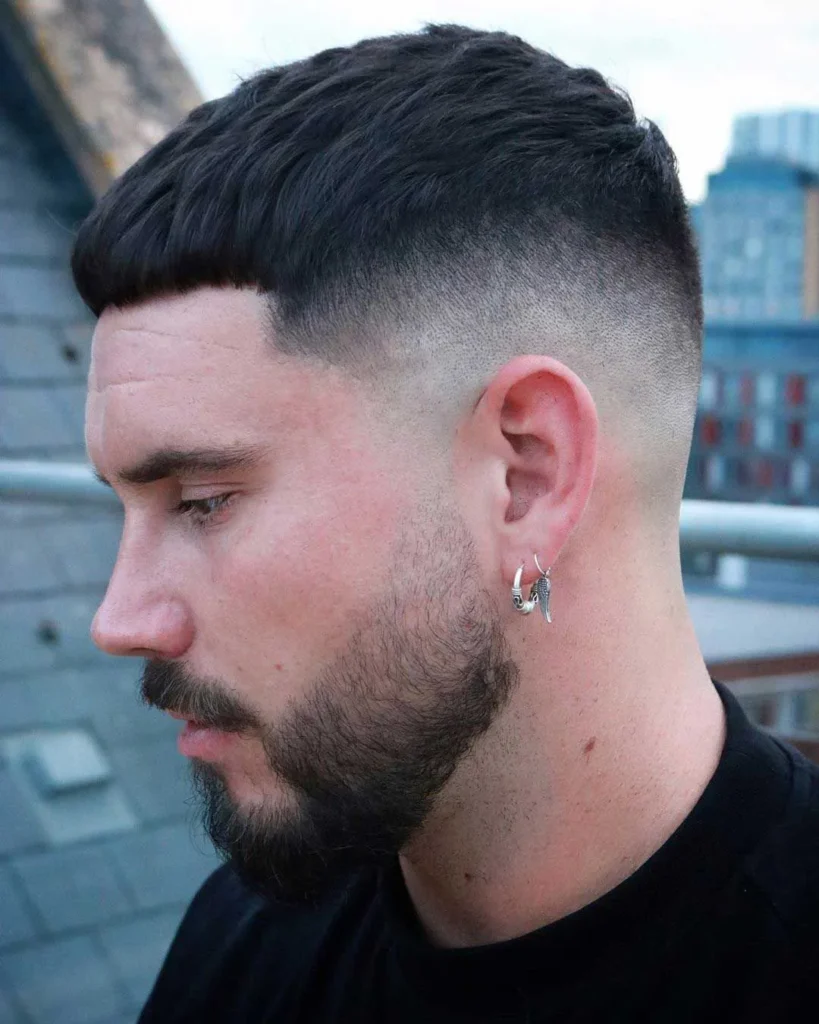
The light Caesar uses a shorter guard (#0–#1), giving the cut a sharper, more breathable finish. It works well in warmer climates and for men who prefer a clean, low-maintenance style. The lighter length also highlights facial features, making it a bold choice for 2025.
Barber Tip: Ask for a #1 guard all over with a clean fringe line — perfect if you want a crisp, professional vibe.
Best Face Shape: Square — the lighter cut defines strong jawlines and sharp cheekbones.
Black Caesar Haircut

The Black Caesar haircut is especially popular in African-American culture, offering a clean, structured style with sharp edges. It’s usually paired with a low or medium fade, enhancing natural hair texture while keeping it neat. This version is versatile, fitting both professional and casual looks.
Barber Tip: Request a low fade with crisp edge-ups to keep the cut fresh and stylish longer.
Best Face Shape: Round — the fade plus shape-up creates definition and balances fullness.
Bald Caesar Haircut
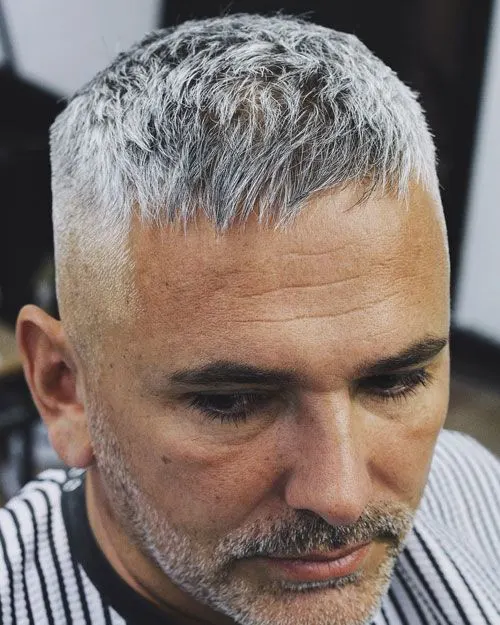
The Bald Caesar haircut blends the classic short fringe of the Caesar with an almost skin-close finish. It’s an excellent choice for men with thinning or receding hair, since it minimizes contrast between scalp and hair. The look is sharp, masculine, and incredibly low-maintenance.
Barber Tip: Ask your barber for a #0–#1 guard all over with a short fringe to keep structure intact.
Best Face Shape: Oval — the bald style flatters natural symmetry without needing added volume.
Caesar Haircut with Beard

Pairing the Caesar haircut with a beard creates a balanced, masculine look that enhances facial structure. The short, straight fringe on top contrasts nicely with the fullness of the beard, adding sharp definition. This combo works especially well for men who want a stylish yet mature appearance in 2025.
Barber Tip: Keep the hairline neat and the beard well-trimmed; fading the sideburns into the haircut makes the transition seamless.
Best Face Shape: Square — the beard softens strong jawlines while the Caesar cut frames the forehead.
Modern Long Caesar Haircut
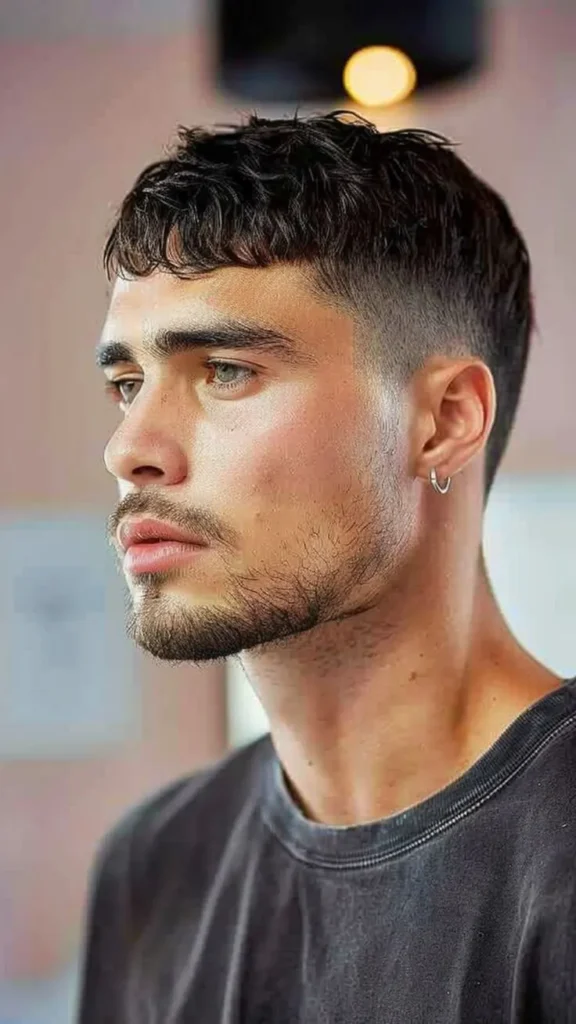
The modern long Caesar cut adds extra length and flow on top while keeping the signature short fringe in front. This variation gives a more relaxed, fashion-forward vibe compared to the classic cropped version. It’s trending in 2025 for men who want structure but with added versatility in styling.
Barber Tip: Ask your barber to keep the fringe blunt but layer the top for natural movement — this prevents the cut from looking flat.
Best Face Shape: Oval — the longer textured flow highlights balanced proportions while keeping the style sharp.
George Clooney Caesar Haircut

The George Clooney Caesar is the 90s version that brought the style back into global popularity. With short, uniform length and a neat fringe, Clooney made it the go-to professional yet stylish cut. Even today, it’s referenced as the cleanest execution of the Caesar look.
Barber Tip: Request a uniform clipper cut around #2–#3 all over, keeping the fringe slightly forward for Clooney’s signature style.
Best Face Shape: Square — the clean lines of this cut soften strong jawlines and give a balanced appearance.
Asian Caesar Haircut
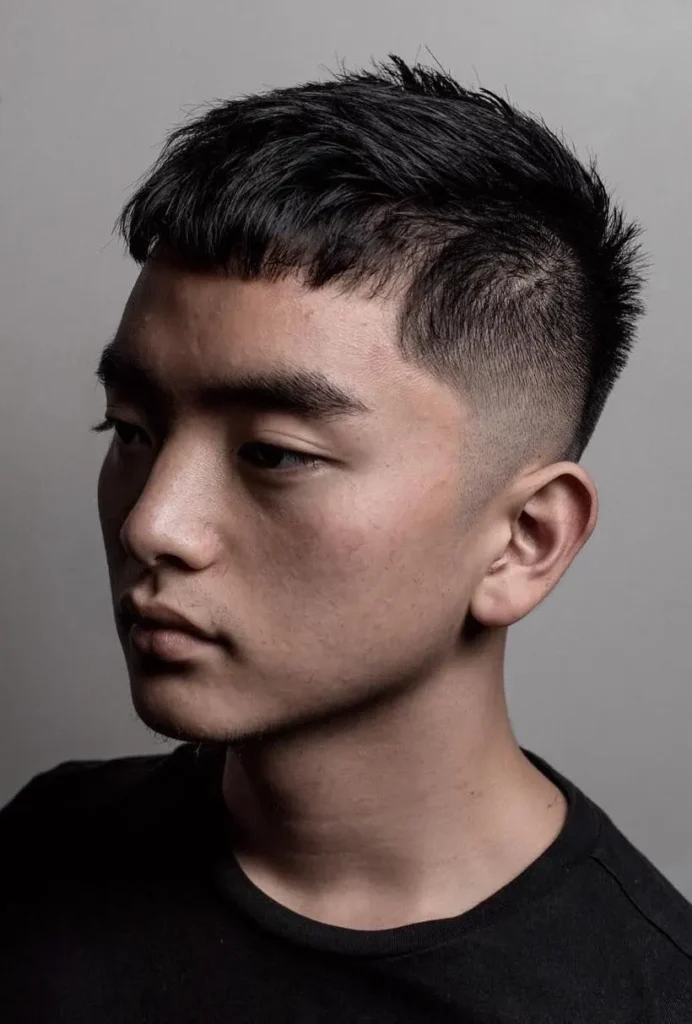
The Asian Caesar haircut adapts the style for straighter, thicker hair textures. It emphasizes a blunt fringe with a smooth, structured finish that sits neatly on the forehead. This version is sharp, low-maintenance, and works especially well with naturally dense hair.
Barber Tip: Ask your barber to keep the top uniform but slightly textured, so the hair doesn’t sit too flat. A clipper on the sides with a subtle taper enhances the clean outline.
Best Face Shape: Oval — the structured fringe highlights symmetry while avoiding excess bulk on the sides.
Women’s Caesar Haircut
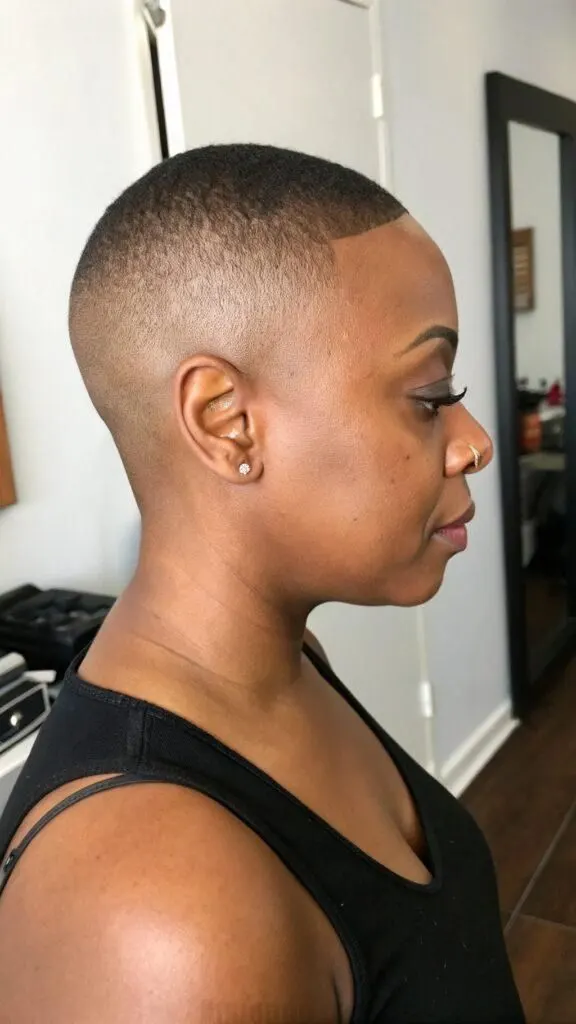
The women’s Caesar haircut is a bold, fashion-forward twist on the classic. It features a cropped fringe and short sides, offering a sleek, androgynous vibe. This look is popular among women seeking confidence, edge, and easy upkeep. In 2025, it’s also a runway-inspired choice, blending minimalism with power.
Barber Tip: Keep the fringe blunt and clean to maintain the iconic Caesar look. For softer femininity, ask for a slightly longer fringe with light texture.
Best Face Shape: Heart-shaped — the strong fringe balances the forehead while keeping focus on the eyes.
Caesar Haircut Fade Styles
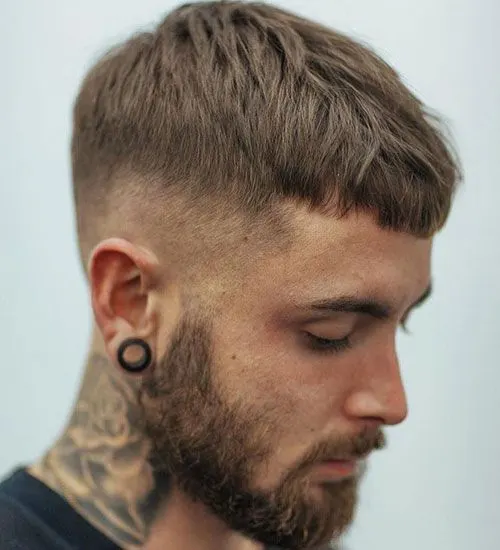
Fade styles add a modern, sharp touch to the classic Caesar haircut. By blending the sides into the top, fades create contrast and a cleaner silhouette. They’re especially popular with men who want a stylish, professional look that transitions well from casual to formal. In 2025, barbers highlight low, mid, and high fades as the most versatile options for Caesars.
Barber Tip: Choose the fade height based on your lifestyle. Low fades are subtle and school-friendly, while high fades give maximum edge.
Best Face Shape: Oval — fades sharpen the look without overpowering natural balance.
Caesar Low Fade Haircut
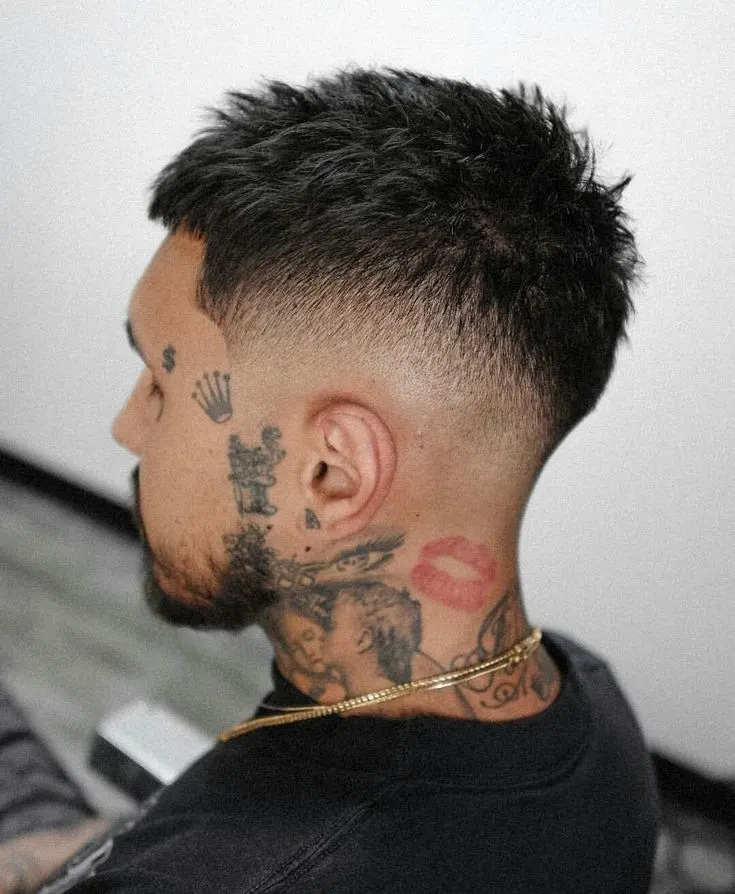
The Caesar low fade blends short sides with a neat fringe on top, creating a subtle yet polished look. It’s perfect for men who want a professional haircut that still feels modern. This style works well in school, at work, or even in more formal settings. In 2025, the low fade Caesar is trending as a go-to cut for men who prefer minimal upkeep with maximum sharpness.
Barber Tip: Ask your barber to keep the fade gradual with a #1–#2 guard for a softer blend.
Best Face Shape: Round — the low fade elongates the face while keeping the style balanced.
Caesar Mid Fade Haircut
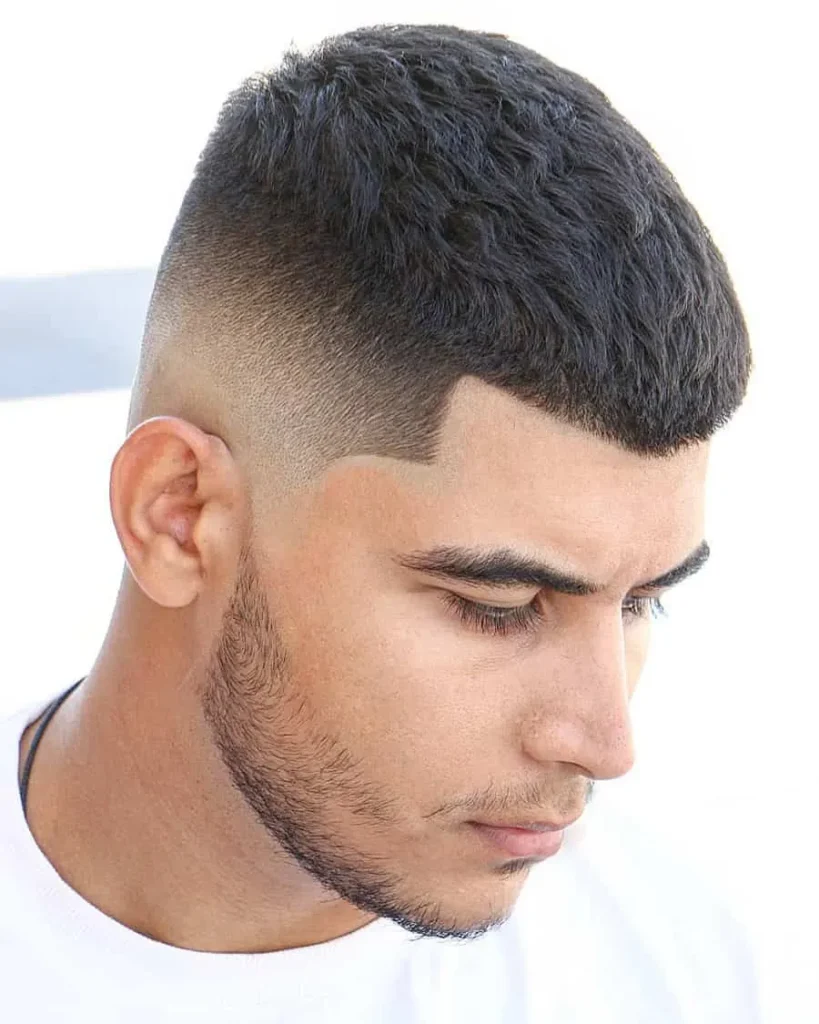
The Caesar mid fade strikes the balance between bold and classic, sitting between the temple and the ears. It adds sharp contrast to the fringe while keeping the overall style versatile. This variation is popular among younger men and athletes who want a stronger edge without going too extreme. In 2025, it’s seen as the “all-rounder” Caesar fade, fitting both casual and semi-formal looks.
Barber Tip: Request a mid fade with a textured fringe to enhance movement on top.
Best Face Shape: Oval — the mid fade highlights symmetry and sharpens natural features.
Caesar High Fade Haircut
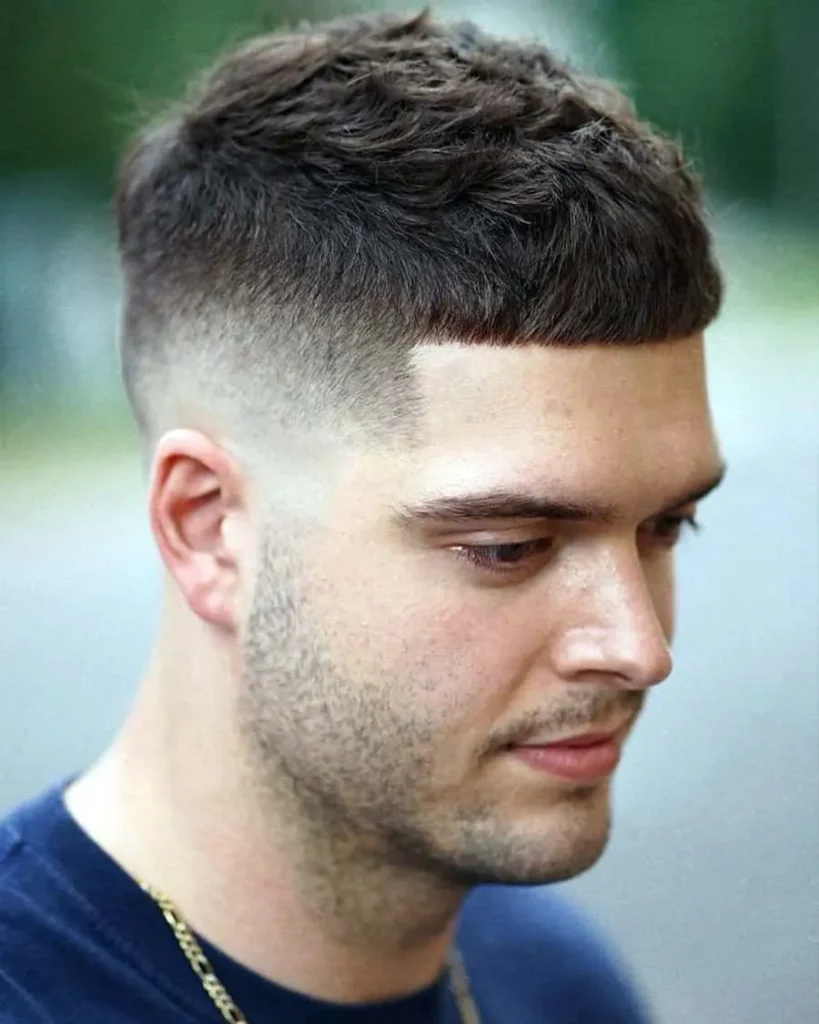
The Caesar high fade is the boldest of the fade variations, starting high on the sides for maximum contrast. It creates a strong, sharp outline that pairs perfectly with the short fringe of the Caesar cut. This style emphasizes the top hair and adds a modern, edgy vibe, making it popular among fashion-forward men in 2025. The high fade also works great for guys who want a clean, standout look with little maintenance.
Barber Tip: Ask your barber to keep the top slightly textured for a natural finish — it prevents the cut from looking too harsh.
Best Face Shape: Round — the high fade elongates the face and adds definition to softer features.
Dark Caesar Fade Haircut
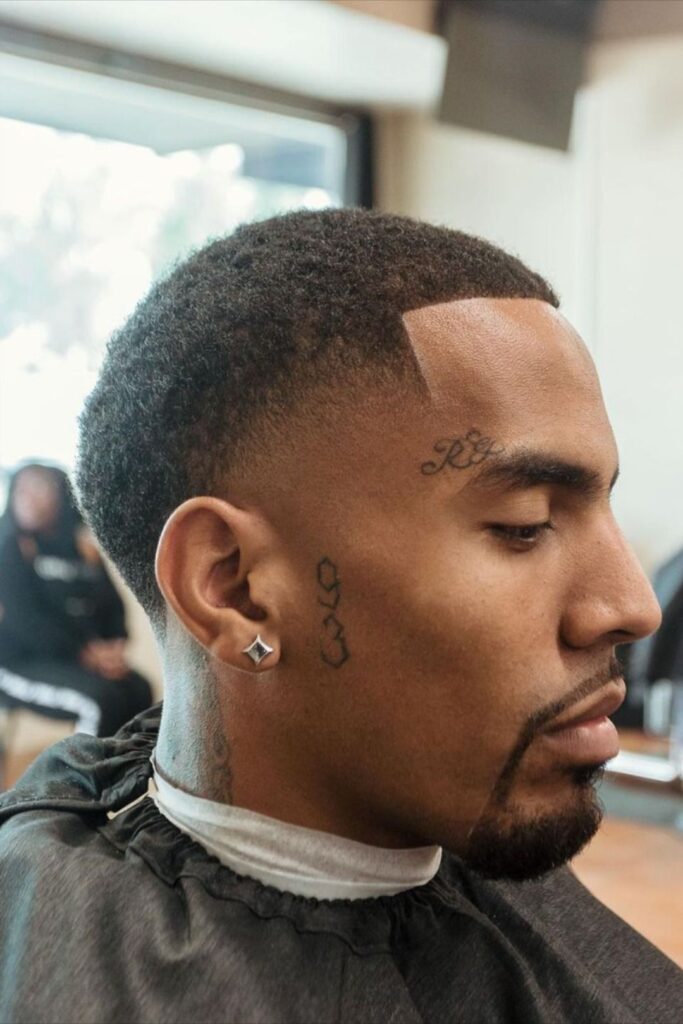
The dark Caesar fade is a variation that keeps the hair slightly longer and fuller on top, giving the cut more depth and richness. It’s especially popular among men with coarse or textured hair, as it allows the natural thickness to shine while staying sharp on the sides. This fade style provides a neat, professional vibe but still feels stylish for casual settings. In 2025, it remains a go-to choice for men who want structure without sacrificing fullness.
Barber Tip: Keep the fade mid to low for balance — it blends better with the thicker top.
Best Face Shape: Oval — the even proportions of this cut complement an already balanced shape.
Caesar Fade for Black Hair
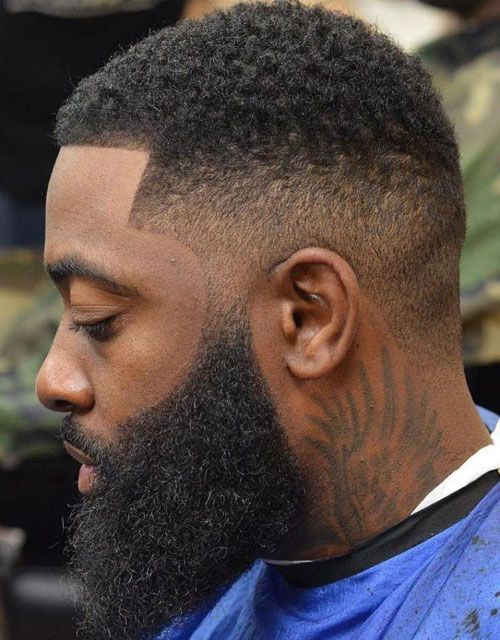
The Caesar fade for Black hair is a staple style that highlights natural texture while keeping the cut manageable. The short horizontal fringe paired with a crisp fade creates a sharp, clean silhouette. Many barbers recommend this look because it balances modern edge with cultural heritage, making it both stylish and meaningful. In 2025, it continues to be one of the most requested Caesar variations in barbershops.
Barber Tip: Use a sponge or brush twist on top for extra texture — it elevates the look instantly.
Best Face Shape: Round — the fade elongates the face while the fringe provides balance.
Caesar Haircut vs Other Styles
Caesar vs Crew Cut
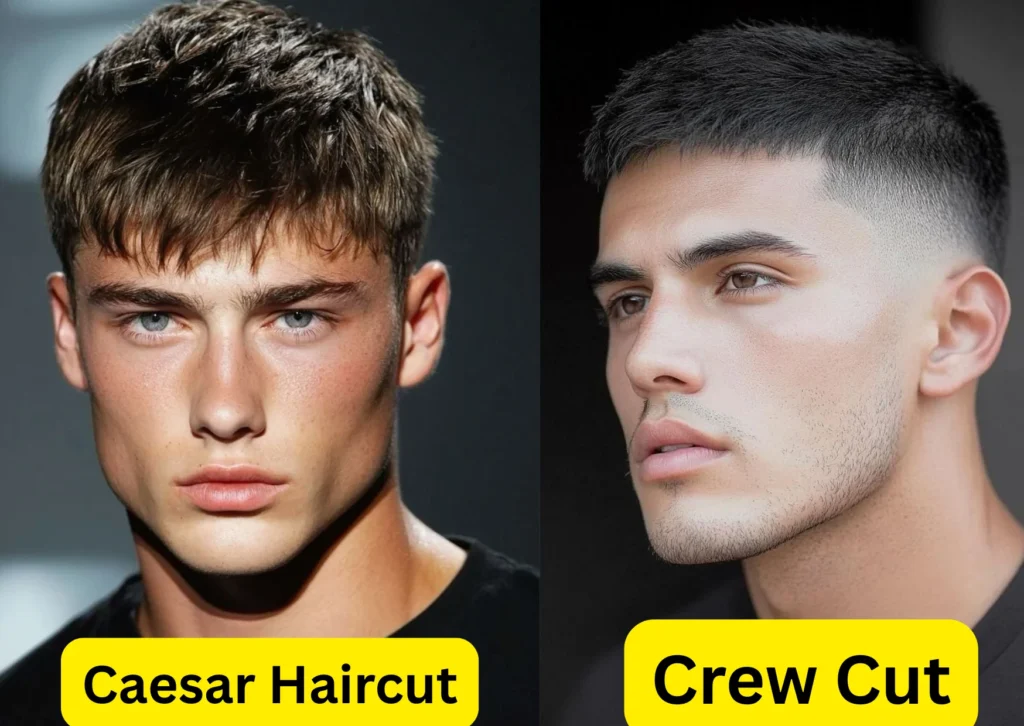
The Caesar and crew cut often get compared because both are short, low-maintenance styles. The key difference lies in the fringe: the Caesar has a straight horizontal front, while the crew cut is brushed up and back. The Caesar offers more coverage for the forehead, making it great for men with receding hairlines. The crew cut, on the other hand, gives a sportier, more open look.
Barber Tip: If you want a professional, sharp vibe, choose the crew cut. If you want balance and face-framing, the Caesar is the better pick.
Best Face Shape: Square — both cuts highlight strong jawlines, but the Caesar softens edges slightly.
Caesar vs French Crop
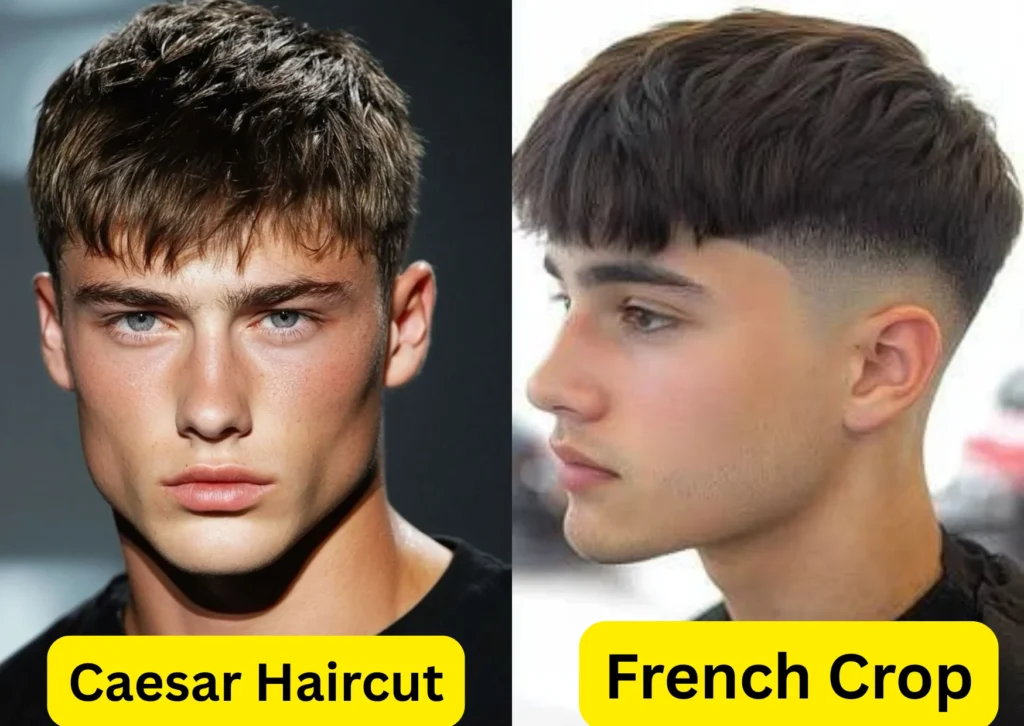
At first glance, the Caesar and French crop look similar, but their details set them apart. The Caesar features a short, uniform fringe that sits flat across the forehead, while the French crop often has a longer, more textured fringe. The Caesar is sharper and more structured, whereas the French crop leans toward a messier, trendier vibe. Both are versatile, but the Caesar is timeless while the crop is more fashion-forward.
Barber Tip: If you prefer easy daily styling, stick with the Caesar. If you like experimenting with texture and products, go for the French crop.
Best Face Shape: Round — the French crop adds height, while the Caesar keeps things balanced.
Caesar vs Buzz Cut
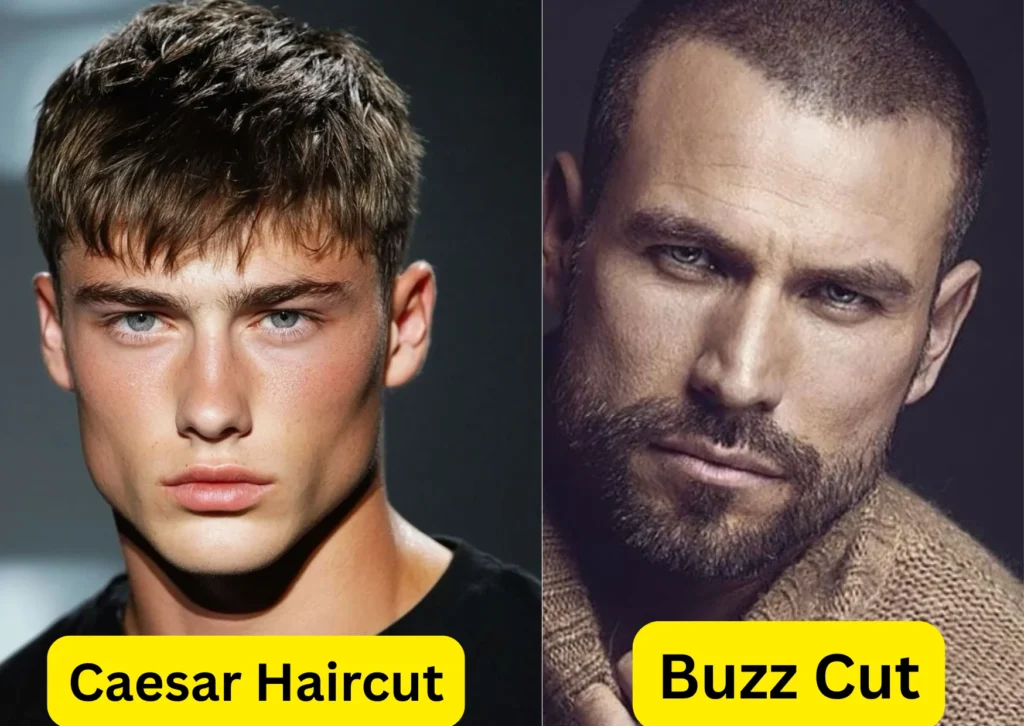
The Caesar and the buzz cut are both short, low-maintenance hairstyles, but they project different vibes. A buzz cut is ultra-minimalist, with hair clipped to a uniform length across the scalp — clean but severe. The Caesar, on the other hand, retains a defined fringe and structured silhouette, offering more personality and styling flexibility. This makes the Caesar a better choice for men who want simplicity without sacrificing style.
Barber Tip: If you’re debating between the two, ask your barber to leave a short fringe for a Caesar — if you don’t like it, it can always be blended into a buzz cut.
Best Face Shape: Square — the Caesar softens edges, while the buzz highlights sharpness.
Caesar vs Edgar Cut
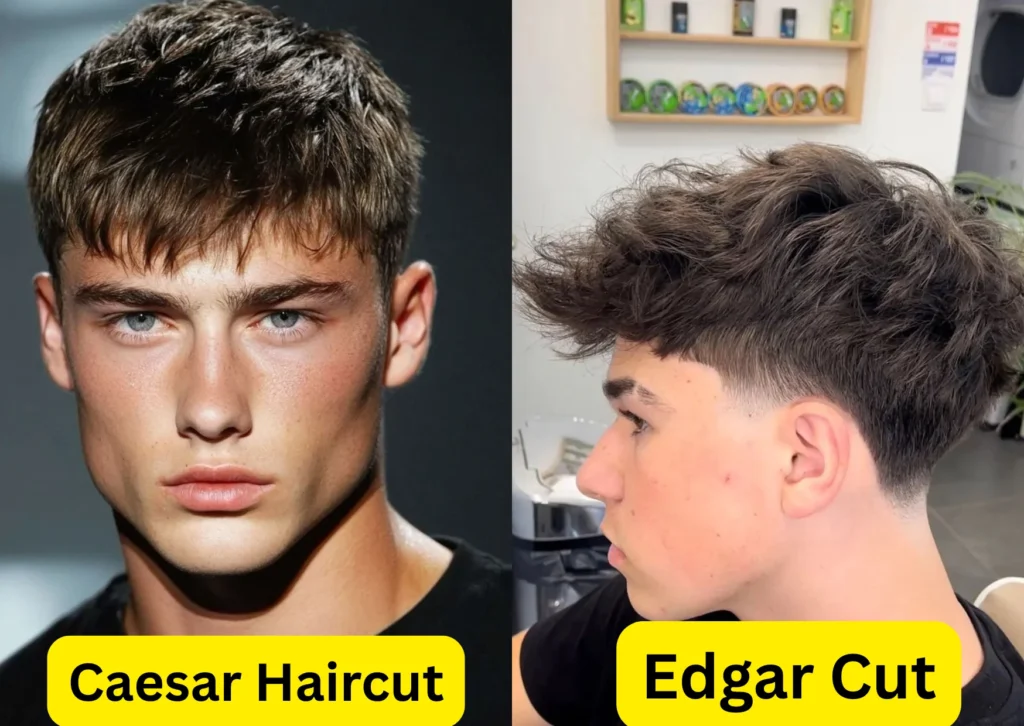
he Edgar cut is often called the “bold cousin” of the Caesar. While both share a straight fringe, the Edgar is more extreme with sharper edges, higher fades, and a boxy, dramatic outline. The Caesar, in contrast, keeps a softer, more natural blend, making it wearable for work, school, and formal settings. The Edgar grabs attention fast, but the Caesar offers timeless balance and versatility.
Barber Tip: If you want to test the Edgar look without going too harsh, start with a textured Caesar and ask your barber to keep the fringe sharper.
Best Face Shape: Oval — the Caesar flatters universally, while the Edgar works best when you already have balanced proportions.
How To Ask for a Caesar Haircut
Communicate clearly with your barber to get the Caesar cut just right. Specify fringe length, side taper, and whether you want a textured, messy, or clean finish. Decide on the fade type—low, mid, or high—as it affects the overall look. Bring a reference photo to avoid guesswork and ensure your barber understands exactly what you want.
Barber Tip: Ask for a uniform cut with a #2 guard to achieve balanced layering across the top and sides.
Barber Terminology (What to Say)
When requesting a Caesar cut, use clear terms: “short horizontal fringe,” “textured top,” and “uniform side taper.” Mention if you want a fade or a blunt edge at the back. Avoid vague descriptions like “just trim it” to prevent misunderstandings. Showing a photo alongside verbal instructions ensures your barber captures the style precisely.
Barber Tip: Always specify the clipper guard number for the sides to maintain consistent length.
Consultation Flow: Start your consultation by describing your daily routine—barbers can suggest fade levels that match your maintenance preference.
Guard Numbers for Caesar Cut
Most barbers use #2 or #3 guards for the sides and back, leaving the top slightly longer for texture. You can adjust based on personal preference or hair density. Clippers create a clean, even look while keeping the fringe distinct. Knowing the guard numbers ahead of time speeds up the process and reduces errors.
Barber Tip: For a sharper look, request blending between the guard lengths for a seamless transition.
Mini Example: #2 on sides, #3 on top = clean yet low-maintenance finish.
What Photo to Show Your Barber
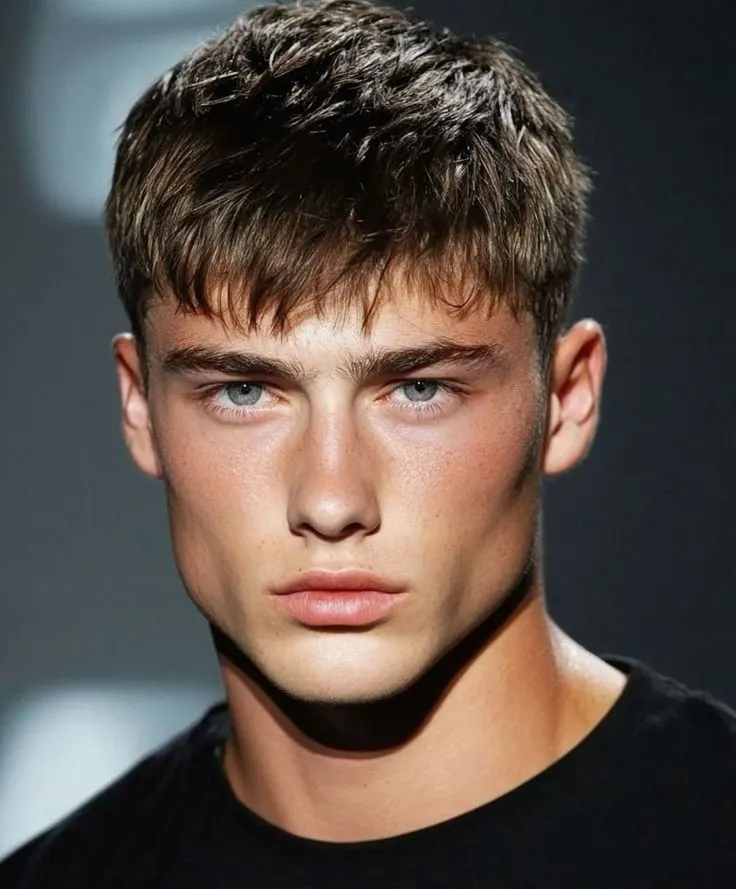
Bring a clear front-facing and side-angle photo of your desired Caesar cut. Photos help demonstrate fringe length, fade style, and texture. Avoid low-quality or outdated images that may confuse the barber. Real-life references make communication effortless and cut time efficient.
Barber Tip: Annotate the photo with the guard numbers or areas you want more texture for extra clarity.
Add-on Tip: Avoid celebrity photos with different hairlines or textures—choose someone with similar hair density and style for accuracy.
Caesar Cut Price & Average Cost
Pricing varies by barber skill, location, and added services like styling or fading. Expect $20–$60 at most standard barbershops, with higher-end salons charging more for textured or specialty finishes. Factors like city, experience, and session length influence cost. It’s wise to confirm prices beforehand to avoid surprises.
Barber Tip: Ask if the price includes styling products or if they charge extra for finishing touches.
Geo Tip: In metropolitan areas like New York or London, expect prices closer to $50–$70 due to higher demand and stylist expertise.
How To Cut a Caesar Haircut (Barber Guide)
Step-by-Step Caesar Cut with Clippers
- Start With Clean, Damp Hair
Wash and towel-dry the hair for easier clipping and even cuts. Damp hair helps clippers glide smoothly and reduces pull.
Barber Tip: Comb hair forward to see natural growth direction and ensure the fringe lays flat.
- Clip the Sides and Back
Use a #2 or #3 guard on the sides, tapering gradually toward the nape. Keep movements steady to avoid uneven lengths.
Barber Tip: Blend with an upward flick to soften transition between sides and top.
- Trim the Top Uniformly
Use scissors or longer guard clippers for the top, maintaining 1–2 inches depending on desired length. Ensure the fringe remains slightly horizontal across the forehead.
Barber Tip: Cut small sections at a time and cross-check symmetry using a mirror.
- Texturize for Natural Flow
Use thinning shears or point cutting on top to add movement and avoid a flat blocky look. This gives the modern 2025 textured Caesar effect.
Barber Tip: Keep texture subtle; over-texturizing reduces the structured appeal.
- Final Check & Clean Edges
Outline around ears and neckline with a trimmer. Double-check fringe, top length, and blending to maintain classic Caesar proportions.
Barber Tip: Step back frequently to view overall balance before finishing.
How To Cut a Dark Caesar Haircut
- Prep Hair Properly
Start with clean, damp hair to see the natural texture and density clearly. Dark hair can appear uneven if dry or oily.
Barber Tip: Use a fine-toothed comb to lift strands—this prevents missing sections and ensures uniformity.
- Use Appropriate Guards
Sides: #2–#3; Top: #3–#4 depending on desired fringe length. Dark hair shows clipping lines more prominently, so precise guard selection is crucial.
Barber Tip: Always start longer; you can shorten gradually. Mistakes are more visible on dark hair.
- Check Lighting & Angles
Dark hair can hide uneven layers in shadows. Use bright light and check from multiple angles during trimming.
Barber Tip: Tilt the head slightly forward and sideways to spot inconsistencies on the fringe and crown.
- Blend & Texturize
Point-cut lightly to reduce blockiness. Blending is key to a soft, natural finish that suits modern 2025 trends.
Barber Tip: Small texturizing snips on the fringe create subtle dimension without compromising structure.
Home Haircut Tips (DIY Caesar Cut)
- Use Quality Clippers & Guards
Invest in adjustable clippers and a set of guards. This ensures consistency and prevents uneven cutting at home.
DIY Tip: Keep a handheld mirror to check the back and sides frequently.
- Start With Slightly Longer Length
Begin with a longer guard on top and sides; you can trim shorter gradually. Overcutting is hard to fix.
DIY Tip: Comb hair forward while trimming the fringe to maintain the horizontal line.
- Divide Hair into Sections
Section top, sides, and back to maintain control. Cut one section at a time for accuracy.
DIY Tip: Small, controlled cuts prevent mistakes and give cleaner results.
- Check & Refine
After cutting, inspect symmetry and blend edges lightly. Touch up any uneven spots carefully.
DIY Tip: Avoid cutting in dim lighting—errors are harder to spot on uneven surfaces.
How To Style a Caesar Haircut (Styling Guide)
Daily Styling Routine (Step by Step)
Start with towel-dried hair after shower. Apply a small amount of lightweight pomade or styling cream. Comb the fringe forward while lifting the top slightly for volume. Finish with light hairspray if needed for hold.
Barber Tip: For fine hair, use your fingers instead of a comb to add texture naturally.
Best Hair Products (Pomade, Clay, Gel)
Pomade works for sleek, controlled looks; clay adds matte texture and volume; gel is best for structured, firm hold. Use sparingly to avoid heaviness.
Barber Tip: Mix a pea-sized clay with a tiny bit of pomade for flexible, long-lasting texture.
How To Maintain Volume & Texture
Blow-dry on low heat while lifting the top with fingers. Avoid heavy conditioners that flatten hair. Finger-style or light texturizing spray keeps natural movement.
Barber Tip: Focus on root lift rather than flattening fringe to preserve Caesar’s structured look.
How To Style Messy or Tousled Caesar Cut
Use texturizing cream or sea salt spray on damp hair. Scrunch lightly and let it air dry or use diffuser for natural waves. Tousled Caesar works well for casual or modern styles.
Barber Tip: Avoid over-styling—less manipulation keeps the fringe soft and fresh.
How To Get the Perfect Fringe
Trim fringe straight across with slight rounding at corners for natural flow. Avoid cutting too short; always start longer. Finger-comb and blow-dry forward for best shape.
Barber Tip: Point-cut fringe ends to reduce heaviness and allow slight movement, especially for thick or wavy hair.
Maintenance & Grooming Tips
Trimming Frequency (Every 2–3 Weeks)
To keep the Caesar cut looking sharp, schedule trims every 2–3 weeks. This maintains the fringe length and clean edges. Regular trims prevent the top from growing too long and losing shape.
Barber Tip: Bring a photo of your last cut to ensure consistency in length and fade.
Home Care Routine for Caesar Haircut
Wash 2–3 times per week with gentle shampoo to avoid stripping natural oils. Condition lightly to maintain softness without flattening texture. Finger-style daily to refresh volume.
Barber Tip: Avoid daily heavy styling products—they weigh hair down and reduce movement.
Best Shampoos & Conditioners
Choose shampoos with mild surfactants for scalp health and conditioners that add light hydration. Avoid silicone-heavy products that make hair greasy or limp.
Barber Tip: For thicker hair, a leave-in conditioner can help tame unruly strands without flattening fringe.
Beard Maintenance with Caesar Haircut
Keep beard neatly trimmed to balance the structured Caesar haircut. Match fade or taper around sideburns for seamless transition. Regular grooming enhances overall style coherence.
Barber Tip: Use beard oil for soft texture and avoid sharp contrasts unless desired for edgy look.
Who Made the Caesar Haircut Famous?
Julius Caesar (The Origin Story)
The Caesar haircut traces back to Julius Caesar, who popularized the short, horizontal fringe in Ancient Rome. It symbolized authority, discipline, and practicality for soldiers and statesmen. Modern barbers still reference this origin when discussing cut structure.
Barber Tip: Understanding the historical roots can help clients appreciate why the cut is universally flattering.
George Clooney (90s Trendsetter)
George Clooney revived the Caesar cut in the 1990s with his sleek, professional style. The look became iconic in Hollywood, blending effortless charm with low-maintenance appeal. Barbers often cite his version as a reference for modern adaptations.
Barber Tip: Ask for a slightly textured fringe like Clooney’s for a natural, versatile look.
Modern Influencers / Celebrities (2025)
In 2025, influencers on Instagram and TikTok have redefined the Caesar cut with subtle fades, textured tops, and layered fringes. Trendsetters showcase its adaptability across face shapes and hair types, keeping the style relevant.
Barber Tip: Bring an influencer photo with similar hair type to guide accurate styling.
Pros and Cons of Caesar Haircut
Why It’s Popular (Pros)
The Caesar haircut is low-maintenance, easy to style, and suits both casual and formal occasions. Its uniform fringe conceals early hair thinning, giving confidence to men of all ages. Celebrities and barbers praise its versatility and timeless appeal.
Barber Tip: Keep the fringe slightly textured for a natural, effortless finish.
Limitations (Cons)
The cut may look flat on very thick or very curly hair if not properly layered. Overly long fringes can appear unkempt, and it may not suit extreme hairline variations without adjustment. Proper barber guidance ensures it stays sharp.
Barber Tip: Trim fringe every 2–3 weeks to maintain shape and prevent a sloppy look.
Is the Caesar Haircut Still in Style in 2025?
Yes, with modern tweaks like soft fades, textured tops, and fringe variations, the Caesar cut remains trendy in 2025. Its balance of simplicity and style keeps it relevant for men seeking low-effort sophistication.
Barber Tip: Add a subtle fade or texture to modernize the classic cut.
FAQs About Caesar Haircut
What is a Caesar Haircut?
A Caesar haircut is a short men’s style with a straight, horizontal fringe and uniform length around the head. It emphasizes clean lines and easy maintenance, making it ideal for men who want style without hassle.
Barber Tip: Ask for a uniform length on top (#3 guard) to keep the classic Caesar shape.
What is a Dark Caesar Haircut?
A Dark Caesar refers to a Caesar cut on naturally dark hair or with added dark tones. It highlights texture and depth, especially with subtle fades or layered tops.
Barber Tip: Use a light styling product to accentuate texture without weighing hair down.
What is a Light Caesar Haircut?
A Light Caesar involves lighter hair shades, either natural or dyed, which emphasizes the fringe and makes texture more visible. It’s popular among trend-conscious men.
Barber Tip: Opt for soft pomade to prevent light-colored hair from looking flat or messy.
How to Style Caesar Haircut?
Styling is minimal: comb fringe forward, use a matte pomade or light clay, and add slight texture on top for modern appeal. Quick blow-drying can boost volume for fine hair.
Barber Tip: For a casual look, tousle slightly with fingers rather than a comb.
How to Cut Caesar Haircut with Clippers?
Use a #2–#3 guard for sides and a #3–#4 on top, trimming fringe straight across the forehead. Blend edges for a clean, uniform finish.
Barber Tip: Work slowly with small sections to avoid uneven lines.
How to Ask Barber for Caesar Cut?
Describe fringe length, top texture, and fade preference. Show a reference photo of someone with similar hair type. Mention maintenance level you want.
Barber Tip: Avoid celebrity photos with different hairlines or textures—choose similar hair density for accuracy.
Is Caesar Haircut Good for Receding Hairline?
Yes, the horizontal fringe can cover early receding hairlines while keeping a structured look. Slightly textured tops prevent flatness.
Barber Tip: Keep fringe shorter and textured for natural coverage.
What Does a Caesar Haircut Look Like?
It’s a short, horizontal fringe with uniform length around the head, clean edges, and sometimes subtle fades. Modern variants include textured or tousled finishes.
Barber Tip: Add a low fade for a modern, stylish update.
Is the Caesar Haircut Still Trendy?
Absolutely. In 2025, Caesar cuts remain fashionable with textured, soft fringes and fade adaptations. They suit men seeking low-maintenance yet sharp looks.
Barber Tip: Modernize by pairing with light styling product and subtle fade.
Why the Caesar Haircut Will Never Go Out of Style
The Caesar haircut endures because it combines simplicity, versatility, and timeless structure. Across decades, from ancient Rome to 90s Hollywood and today’s street style, it has proven adaptable for all hair types and ages. Its low-maintenance nature makes it perfect for busy lifestyles while still looking polished.
Barber Tip: Regular trims every 2–3 weeks preserve the crisp fringe and structured look, keeping the Caesar cut sharp year-round.
The cut’s universal appeal lies in its balance—it’s bold enough to make a statement but subtle enough for professional settings. In 2025, adding textured tops or soft fades modernizes the classic style, allowing personalization without losing its iconic identity.
For men exploring timeless styles, the Caesar haircut offers a combination of confidence, ease, and style longevity that few haircuts can match. Its adaptability ensures it remains relevant for decades to come.
Pair with a simple grooming routine, the right hair products, and regular barber visits to keep the Caesar cut looking fresh and modern.




